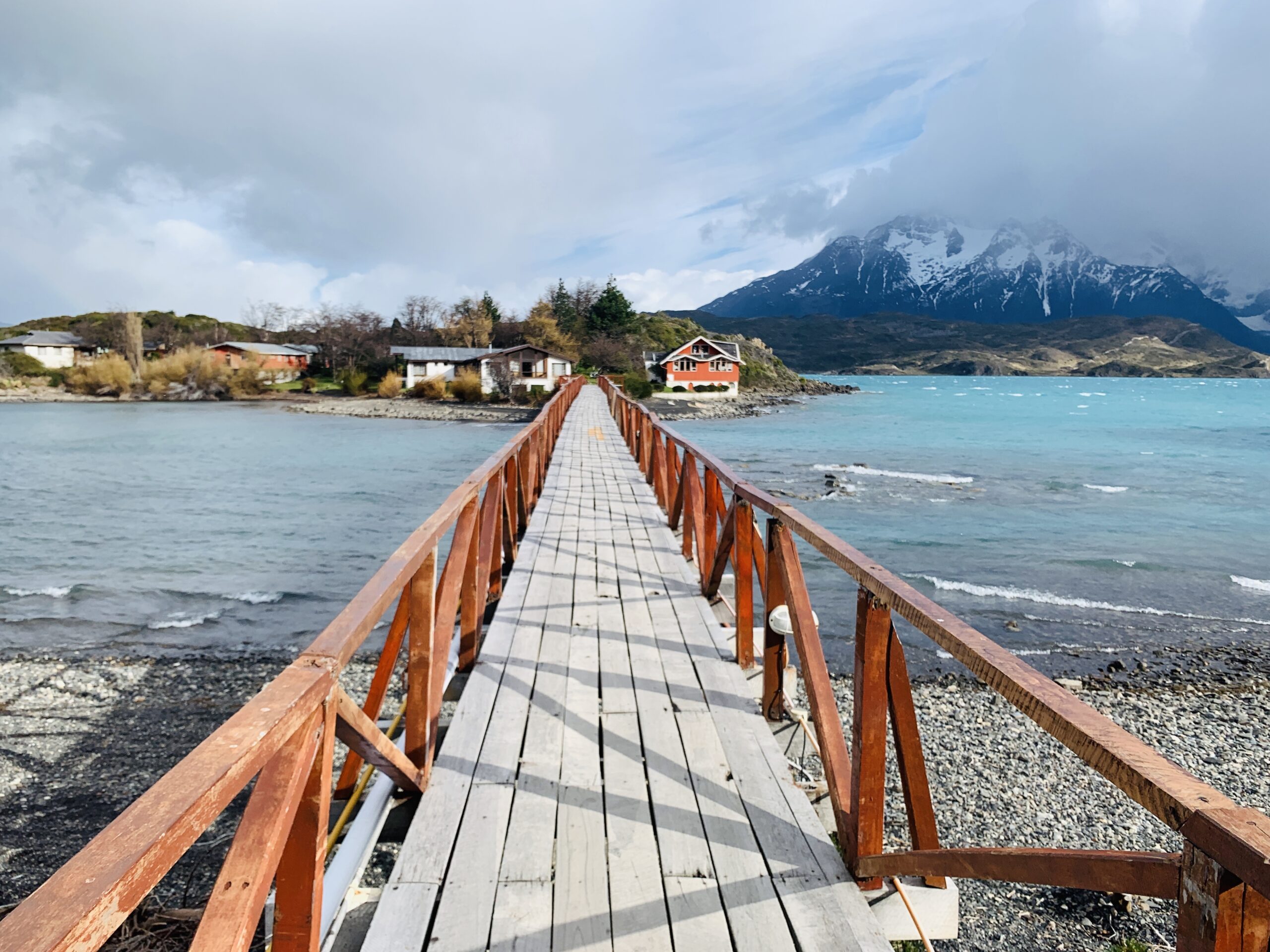The Ultimate Travel Guide For Patagonia
True confession: I didn’t even know where Patagonia South America was when I first agreed to go on the trip. Then the shellshock of the 26-hour journey to get there set in – flights to Patagonia are not that flexible. Then, the fact that I was embarking on a solo travel trip to Patagonia Chile kicked in so be sure to read my article at on the Lonely Planet Chile page. But all that quickly gave way to excitement when I realized all that the destination had to offer. There’s a lot to consider when planning a trip to the Patagonia mountains.
Where is Patagonia?
Patagonia is located at the Southernmost point in South America straddling Argentina and Chile. It is one of the most popular destinations among outdoor enthusiasts. What many travelers don’t realize is that it’s also an amazing food and wine destination that also offers a touch of luxury and a laid-back lifestyle. It’s a vast region that’s perfect for a little exploration, engagement, and indulgence. From turquoise blue lakes to towering granite cliffs to glaciers and icebergs, there’s so much to take in. No matter how you like to venture out, Patagonia has something to tickle every travel bone. The region attracts outdoor enthusiasts for its diverse terrain, foodies for its hearty and soulful cuisine, and nature lovers who appreciate the flora and fauna. Hiking in Patagonia is a bucket list item for many. Its distance and geography might make it seem like a difficult trip, but with the right planning it doesn’t have to be.
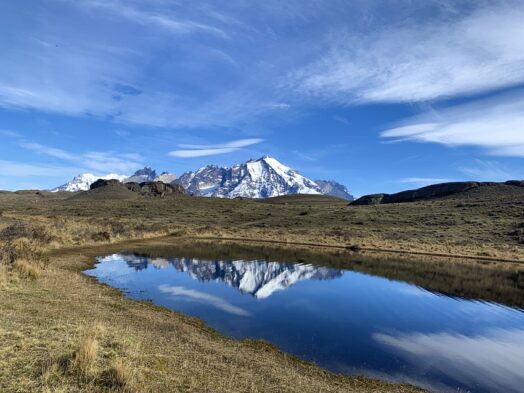
Read my article on Orbitz about “Bucket list how-to: Glamping and trekking in Patagonia.”
Where To Stay In Patagonia
I was most excited about my accommodations at Patagonia Camp, one of the few Patagonia Chile resort destinations. This was glamping (upscale camping) at its best, but the accommodations were much more luxurious that I ever expected. I mean, if the Four Seasons offered yurt accommodations, these would be them! Initially, I was reminded of that time I stayed in a Bedouin tent in Jordan and saw the biggest spider of my life, but once I settled in, the level of comfort and luxury gave me peace of mind. If you’re planning a trip to Patagonia, this is the place to stay.
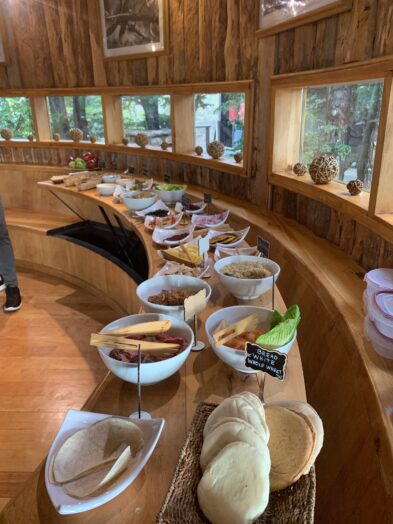
Read my article on Lonely Planet, “I went on a solo trip to Patagonia (and I loved it)”
Luxury Glamping in Patagonia
There’s nothing like laying in your bed at night, in one of the world’s most remote locations (that 26-hour journey entailed a 6-hour car ride to the bottom of the continent across vast areas of nothingness), and staring up at the stars at night through the glass window in the top of yurt. Magical! Each yurt (there are only 20 of them) is spaced out so you really do feel like you’re camping in the wilderness all alone.
My yurt had a king-sized bed but there are also a couple of adjoining yurts for families. And a few of them even have a hot tub on the outside deck. I failed to mention the garden tub that came in handy after those chilly days of hiking. Sustainability is important at the resort so the amenities are all biodegradable so that the reclaimed water can be returned to nature (so leave your shampoo and soap at home). It was truly one of the coolest experiences I’ve ever had in terms of accommodations. There are a few other Patagonia Chile hotels in the region, and also a few hotels in Puerto Natales, a nearby town.
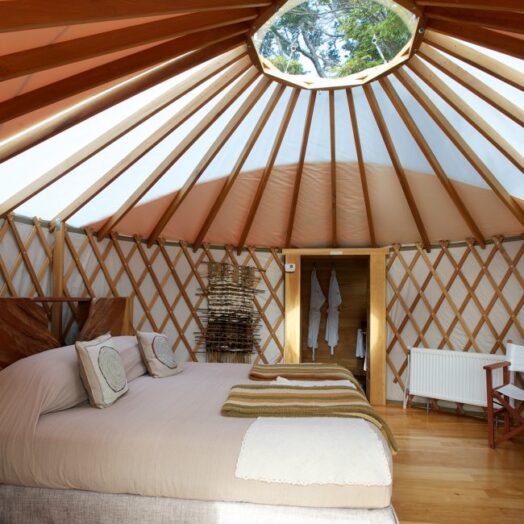
What To Do In Patagonia
Patagonia Camp is just on the outskirts of Torres del Paine National Park. One of the main reasons travelers choose Patagonia Camp is for the guided excursions hosted by local guides. Each evening, guests of the resort gather with the guides to talk about the plans for the next day, often dictated by weather followed by skill level. Hiking in Patagonia is probably the most popular activity. The national parks offers dozens of trails, each offering a different perspective of the region. There’s so much to learn about the history, topography, and climate of the region. Local guides offer a well-rounded education for your Patagonia travel. The first day, we set out for the Flora and Fauna Trail. We received the requisite talk about what to do if you encounter a puma. Seeing the pumas is a good day on the trail and we got lucky! Our guide shushed our group, pulled out her binoculars, and spotted two pumas in the distance chasing a pack of guanacos. Condors circled overhead with their majestic 12-foot wingspan. We saw remnants of where guanacos (South America’s version of the llama) dug pits in the ground to bathe themselves in the sand.
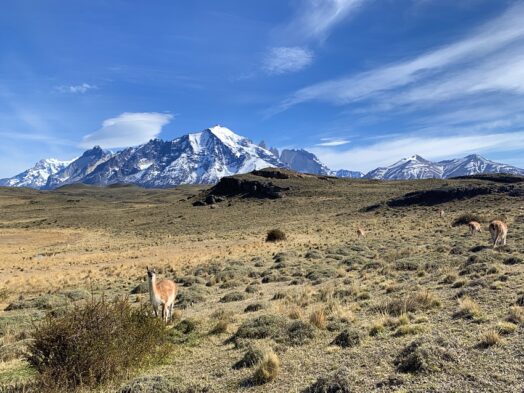
Wildlife in Patagonia
Patagonia, a vast and rugged region spanning southern Argentina and Chile, is home to an incredible diversity of wildlife, thriving in its dramatic landscapes of windswept plains, towering mountains, and glacial lakes. The region is a sanctuary for unique species, including the elusive puma, also known as the mountain lion, which roams its grasslands and forests. Guanacos, relatives of the llama, are commonly spotted grazing across the steppe, while Andean condors soar majestically above the cliffs. Patagonia’s coastal waters host vibrant marine life, such as southern right whales, elephant seals, and Magellanic penguins, creating a haven for nature enthusiasts and wildlife photographers. This rich biodiversity makes Patagonia a premier destination for eco-tourism and conservation efforts.
Patagonia for the adventurer
This region is a hiking mecca with everything from rigorous overnight treks to short immersive strolls. The 600,000-acre Torres del Paine National Park is for those looking for outdoor adventures between tranquil to the treacherous. The park’s three towering peaks are the main attraction with the tallest summit, Cerro Paine Grande, at 9,500 feet. This peak attracts technical climbers for its challenging ascent with the pinnacle being its photo-worthy spot at the top.
Patagonia hike enthusiasts will know the W trail, a 50-mile, 5-day trek that lets adventurers experience all the park has to offer from expansive views to local wildlife to feats of nature. The full hike is of moderate difficulty but many sections are also possible to do as day hikes. Need a bit more exertion? The O Circuit is a 85-mile weeklong route that is both challenging and rewarding. There are several campsites along both routes so you’ll want to be sure to book them in advance. Some areas of the park require hikers to travel with a certified guide. It’s a great way to learn about the topography and terrain through the eyes of a local.
Patagonia Travel For The Nature Lover
Torres del Paine was designated a World Biosphere Reserve by UNESCO in 1978 for its unique ecological zones. These zones include the Andean Desert, Magellanic subpolar forest, Pre-Andean shrubland, and Patagonian steppe. So there’s a bit of everything for nature enthusiasts and especially for conservationists. The Flora and Fauna Trail offers a glimpse of it all including guanacos (indigenous to the region and similar to a llama or alpaca) to the fast-moving hunters, pumas, to all types of flowering plants and trees that survive the harsh conditions. And having the right guide on your Patagonia hiking tours is key to learning about all of these unique ecosystems. Serious birdwatchers travel to Patagonia in hopes of spotting all 15 of the park’s different birds of prey, including the Andean condor with its massive 10-foot wingspan.
How To Enjoy Patagonia If You Love Leisure
If you want to experience Patagonia travel at your own pace, you’re in good company. Boat excursions are perfect for travelers who want to take it easy with a ride through the region’s iconic blue glaciers. Depending on the weather, the region’s lakes offer plenty of relaxing water experiences. You can paddle around a calm bay in a kayak, take a boat trips, and capture selfie moments among glaciers and icebergs. There’s also horseback riding, fishing and fly fishing, and spots to relax with a picnic and stellar views. Also, there’s a bike tour through Puerto Natales that’s a great way to breathe the fresh air when the weather is conducive.
Luxury Travel To Patagonia
If you’re hiking the park’s W, you’ll be roughing it outdoors in a tent for a few nights but there’s another camp you should consider. Patagonia Camp is the region’s only luxury yurt resort. The 20 impeccably designed yurts each include en-suite bathrooms and locally handcrafted furniture and decor. The rooms are warm and spacious with a glass ceiling perfect for late night stargazing from your bed.
Some of the suites also include hot tubs on the outdoor deck. It’s glamping at its finest with stunning views of the region’s mountains and lakes. The resort prides itself on sustainability and provides eco-friendly, biodegradable amenities so that the reclaimed water can be returned to nature (so leave your shampoo and soap at home). Patagonia Camp has its own guides and a full menu of excursions available. If you prefer to stay inside the park, Explora in Torres del Paine offers all-inclusive luxury accommodations with an indoor spa.
Hiking in Patagonia
Each day was a new adventure. Hiking in Torres del Paine National Park, trekking, visiting waterfalls, and simply relaxing at the camp. One day, I tagged along with a guide who introduced me to maté, South America’s version of an energy drink. She knew I had a fascination with gauchos (the Chilean cowboys), so she took me to a nearby puesto (a tiny cabin where gauchos typically shelter) and we shared a gourd of maté.
The final day of our trip, a bittersweet one, was a bucket list experience for sure. We walked along the shores of Lake Grey to see the ice fields and icebergs. I never knew how an iceberg could make me so happy.
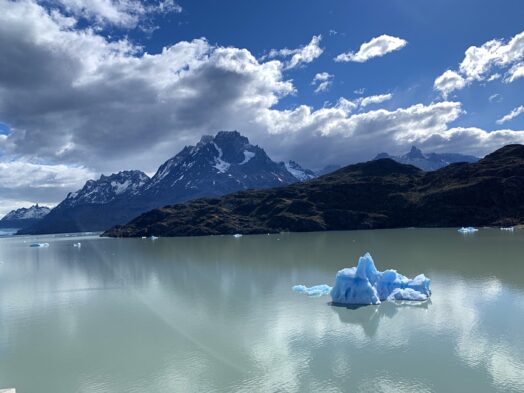
Dining in Patagonia
Patagonia is known for its hearty comfort foods to provide the necessary energy for navigating the region’s rugged trails. If you enjoy seafood and meat, especially lamb, you’ll be happy with the food selections. Dining within the park is limited to a few hotels and cafeterias so you’ll want to do your research. Right outside the park, guests at Patagonia Camp enjoy a more fine dining environment with a full buffet breakfast, boxed lunches to take along on daily excursions, and a chef-inspired three-course dinner. There’s also a full bar that serves some of the region’s coveted Chilean wines. If you’re looking for a wider selection of more traditional dining options, Puerto Natales is your spot. Be sure to check out the town’s quaint coffee shops and craft breweries.
Getting to Patagonia
I’m not going to lie. It’s not easy to get to Patagonia and it’s a l-o-n-g trip. But it is SO worth it! Getting to Patagonia from the U.S. typically involves flying into one of the major gateway cities in Argentina or Chile, such as Buenos Aires (Ezeiza International Airport – EZE) or Santiago (Arturo Merino Benítez International Airport – SCL). From there, travelers can take connecting flights to regional airports closer to Patagonia’s main attractions. Popular entry points include El Calafate (FTE) and Ushuaia (USH) in Argentina, as well as Punta Arenas (PUQ) and Puerto Natales (PNT) in Chile. Flights from the U.S. to these cities often require one or two layovers, depending on the departure city, and may take 12–20 hours in total travel time. Once in Patagonia, renting a car is a great option for exploring remote areas, although buses and guided tours are also available for those who prefer not to drive. Travelers visiting multiple regions may need to cross the Argentina-Chile border, so it’s important to carry proper documentation and check visa requirements in advance. While getting to Patagonia requires careful planning and long travel hours, the journey is well worth it for the chance to experience one of the world’s most breathtaking and remote wildernesses.
Weather in Patagonia and When Is the Best Time to Visit Patagonia
Patagonia is known for its unpredictable and diverse weather, which can change drastically within a single day. The climate varies significantly depending on the location, with the western areas near the Andes experiencing heavy rainfall and lush greenery, while the eastern plains, or steppes, tend to be dry and windy. Summer, which runs from December to February, is widely regarded as the best time to visit, offering longer daylight hours, milder temperatures, and relatively calmer winds, making it ideal for hiking, trekking, and exploring iconic landmarks like Torres del Paine National Park and the Perito Moreno Glacier. However, travelers should still pack layers, as temperatures can range from 40°F to 70°F (4°C to 21°C) even during summer, and sudden rain showers are common. Spring (September to November) and fall (March to May) can also be good times to visit for those seeking fewer crowds and stunning seasonal colors, although temperatures are cooler, and the weather remains unpredictable. Winter (June to August) brings snow to the mountains, attracting skiers and winter sports enthusiasts, but many hiking trails and tourist facilities may be closed during this off-season. Ultimately, Patagonia’s dramatic landscapes and outdoor adventures are worth experiencing year-round, but visitors should plan their trips carefully based on their preferred activities and tolerance for the region’s ever-changing weather.
Packing For Patagonia Travel
Learning that I would potentially be experiencing four seasons in just one week, my OCD packing kicked into gear – literally. I mean, I’m a Florida girl, I had no gear! But it gave me a great excuse to invest in some new fashionable, hiking attire (is that an oxymoron?). Be sure to research Patagonia Chile weather before you go, and especially Torres del Paine national park weather before you go. Spend some time researching the different packing strategies out there. And plan to layer, layer, layer. I also found this information valuable when I was packing for my safari.
Get my Patagonia Packing Guide.
Let me know if you go! And send me a photo of an iceberg!
Sign up for the Foodies for Travel newsletter and get a FREE copy of
“The Ultimate Foodie’s Guide to Italy.”
Click here to sign up.
This blog post may contain affiliate links, meaning that if you click on a link and make a purchase, I may receive a small commission at no extra cost to you. I only recommend products and services I truly believe in and use myself.

